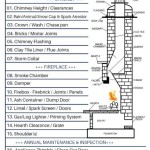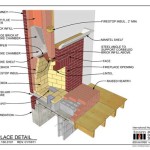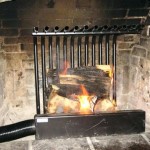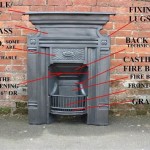Family Room Furniture Arrangement With Fireplace And TV: A Comprehensive Guide
Arranging furniture in a family room that incorporates both a fireplace and a television presents a considerable design challenge. These two focal points often compete for attention, requiring careful planning to create a cohesive and functional space. The arrangement must balance aesthetics with practicality, optimizing viewing angles for both the television and the fireplace while ensuring comfortable traffic flow and maximizing available space. This article explores various strategies for achieving an effective furniture arrangement in a family room featuring both a fireplace and a television.
Understanding the Room's Architecture and Dimensions
Before moving any furniture, a thorough assessment of the room's architecture and dimensions is essential. This includes accurately measuring the room's length, width, and height, noting the placement of windows, doors, and any architectural features like built-in shelves or alcoves. Understanding these constraints will significantly influence the furniture arrangement. For instance, the location of windows may limit the placement of the television due to glare, while the position of doorways will dictate primary traffic paths.
Consider the shape of the room. Is it a rectangular space, a square, or an irregular shape? Rectangular rooms offer more flexibility in furniture placement, allowing for distinct zones for viewing, conversation, and perhaps even a small reading nook. Square rooms can be more challenging, often requiring a more symmetrical arrangement to maintain balance. Irregularly shaped rooms demand creative solutions, focusing on maximizing usable space and minimizing awkward angles. Sketching a rough floor plan to scale will help visualize different arrangements and identify potential problems before physically moving furniture.
Pay close attention to the fireplace's position. Is it centrally located on a wall, or is it offset to one side? A centrally located fireplace naturally lends itself to a symmetrical furniture arrangement, while an offset fireplace requires a more asymmetrical approach to achieve balance. Also, note the fireplace's size and style. A large, imposing fireplace will command more visual attention than a smaller, more understated one, influencing the scale and placement of surrounding furniture.
Prioritizing Focal Points: Fireplace vs. Television
The first critical decision in arranging a family room with a fireplace and television is determining the primary focal point. In some cases, the fireplace will be the dominant feature, particularly if it's an architectural statement piece or frequently used. In other cases, the television will take precedence, especially in households where entertainment is a central activity. There is no single correct answer; the choice depends on individual preferences and lifestyle.
If the fireplace is the primary focal point, the furniture arrangement should emphasize its presence. This might involve centering the seating area around the fireplace, with the television placed to the side or above the mantel. Placing the television above the mantel is a common solution, but it's important to consider viewing height and potential heat damage to the television. A swivel mount can help adjust the viewing angle.
If the television is the primary focal point, the seating should be arranged for optimal viewing. This often means directly facing the television, with the fireplace serving as a secondary element. In this scenario, consider placing the fireplace and television on separate walls to avoid competition. If they must be on the same wall, try to create a visual separation by using different colors, textures, or architectural details.
Regardless of which focal point takes precedence, it is crucial to avoid creating a visual conflict. This can be achieved through careful placement of furniture, strategic use of lighting, and thoughtful selection of accessories. The goal is to create a harmonious and balanced space where both the fireplace and television can coexist without overwhelming the other.
Consider the size of the television in relation to the room's dimensions. A massive television in a small room can be visually overwhelming and uncomfortable to watch. Conversely, a small television in a large room may be difficult to see. Follow the recommended viewing distance guidelines based on screen size to ensure a comfortable viewing experience. The further the viewer is from the screen, the larger the screen should be.
Furniture Placement Strategies for Optimal Functionality
Once the focal points have been established, the next step is to strategically place furniture to create a functional and comfortable living space. This involves considering traffic flow, seating arrangements, and the overall feel of the room.
Traffic flow is a critical consideration. Ensure that pathways are clear and unobstructed, allowing people to move freely through the room without having to navigate around furniture. Avoid placing furniture directly in front of doorways or creating bottlenecks that impede movement. Aim for a minimum of 30 inches of clearance for walkways.
Seating arrangements should be conducive to conversation and relaxation. Consider the size of your family and how often you entertain guests. A large sectional sofa can accommodate a crowd, while a smaller sofa and a few armchairs may be more suitable for a smaller family or a more intimate setting. Aim for a mix of seating options to cater to different needs and preferences.
When arranging seating around a fireplace, consider the heat it radiates. Avoid placing furniture too close to the fireplace, as this can be uncomfortable and even pose a fire hazard. A distance of at least three feet is generally recommended. A heat shield can also be used to protect nearby furniture.
If placing the television above the fireplace, ensure that the viewing height is comfortable. The center of the screen should be at eye level when seated. If the television is too high, it can strain the neck and cause discomfort. A tilting mount can help adjust the viewing angle to compensate for a higher mounting position.
Incorporate other furniture pieces to enhance the room's functionality and aesthetics. Coffee tables provide a convenient surface for drinks, snacks, and remote controls. End tables offer additional storage and display space. Bookshelves can add visual interest and provide a place to store books and other decorative items. Rugs can help define the seating area and add warmth and texture to the room. Opting for rugs with colors and patterns that complement the overall design can tie the space together.
Lighting plays a crucial role in creating a comfortable and inviting atmosphere. Use a combination of ambient, task, and accent lighting to create a layered effect. Ambient lighting provides overall illumination, while task lighting is used for specific activities like reading or working. Accent lighting highlights architectural features or artwork. Dimmers can be used to adjust the lighting levels to suit different moods and activities. Natural light should also be considered. Avoid placing furniture in a way that blocks natural light from entering the room.
Consider incorporating storage solutions to keep the room organized and clutter-free. Built-in shelves or cabinets can provide ample storage space for books, games, and electronics. Ottomans with hidden storage compartments are a versatile option for storing blankets, pillows, and other items. Baskets and decorative boxes can be used to corral smaller items and keep them out of sight.
Experiment with different furniture arrangements until you find one that works best for your needs and preferences. Don't be afraid to try something new or to rearrange furniture periodically to refresh the look of the room. Remember that the goal is to create a space that is both functional and aesthetically pleasing, reflecting your personal style and creating a welcoming atmosphere for family and friends.
Ultimately, the most successful furniture arrangement is one that maximizes comfort, functionality, and style, creating a harmonious and inviting space where family and friends can gather and enjoy each other's company.

This Is The Layout Yessss With Tv And Fireplace On Separate Diffe Walls Sectional Sof Livingroom Living Room Arrangements Family

Layout A Living Room With Tv Fireplace Florida Leather Gallery

16 Ideas For Living Room Layouts With A Fireplace Modsy Blog Decor Narrow Livingroom Layout
7 Inspirational Living Room Layout Ideas Heat Glo

How To Position Your Fireplace Furniture Together

7 Ways To Arrange A Living Room With Fireplace

Living Room Layouts With Fireplace Tvs Direct Fireplaces

How To Arrange Living Room Furniture With A Fireplace And Tv Cow
:strip_icc()/102917832-0b84a075c81c49d3a4e9d9f0c2e494a9.jpg?strip=all)
Living Room Layouts To Make The Most Of Your Gathering Space

How To Arrange Furniture With Two Focal Walls Emily Henderson








